|
|
|
Sort Order |
|
|
|
Items / Page
|
|
|
|
|
|
|
| Srl | Item |
| 1 |
ID:
114442
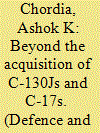

|
|
|
|
|
| Publication |
2012.
|
| Summary/Abstract |
Infiltration, skirmishes and wars on the borders, terrorist attacks
in cities, the Naxalite menace, natural calamities, major accidents,
evacuation of expatriates from troubled foreign countries, humanitarian
aid to foreign countries, reconstruction and development in war-torn
friendly countries - the response to all these situations and many more,
demands large-scale movement of men and material. Often, secrecy is
essential; always, time is of the essence. Reliable airlift capability and
prompt action is the lifeblood of such missions. A timely airlift of troops
by the Indian Air Force (IAF) to the Maldives frustrated the designs
of a band of terrorists and averted a coup d'état in November 1988.
Operation Cactus was a shot in the arm for Indian diplomacy. In some
ways, India continues to gain from the stature thus attained. Airlift
capability is a powerful tool for pursuing foreign policy objectives
through employment of resources and capabilities. It has the power to
change attitudes and build perceptions.
|
|
|
|
|
|
|
|
|
|
|
|
|
|
|
|
| 2 |
ID:
114445
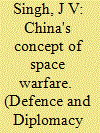

|
|
|
|
|
| Publication |
2012.
|
| Summary/Abstract |
Space warfare will be an integrated part of battle planning by the
Chinese People's Liberation Army (PLA) in any future conflict. One
of the major proponents of integrated space power for the PLA, Maj
Gen Cai Fengzhen, believes that control of portions of outer space is
a natural extension of other forms of territorial control, such as sea
or air control. China's contemplation of the military use of space has
focussed on two broad areas, namely, how to use space in military
operations to increase its offensive capability, and how to use space
in military operations to deny space capabilities to adversaries
|
|
|
|
|
|
|
|
|
|
|
|
|
|
|
|
| 3 |
ID:
114449
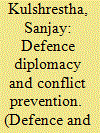

|
|
|
|
|
| Publication |
2012.
|
| Summary/Abstract |
Although the 19
th
century "gunboat" and "parade ground" diplomacy
is of historical interest, a convenient starting point can be 1964, when
the British Secretary of State for Defence, Denis Healey, formulated
the first cohesive defence diplomacy policy. With the withdrawal
from East of Suez, Healey hoped to fill the void and maintain British
influence by a low cost policy playing to perceived British strengths
of military prowess and technological capability. Small training
missions, defence attaches and sales of military hardware were the
three main components of the plan, backed up by occasional military
deployments, high level visits, and the opening up of the domestic
defence establishments to allied military personnel.
1
|
|
|
|
|
|
|
|
|
|
|
|
|
|
|
|
| 4 |
ID:
114443


|
|
|
|
|
| Publication |
2012.
|
| Summary/Abstract |
For the continuity of India's rise as a great power, it is necessary for
us to have a clear perspective on our foreign policy goals and the
methodology to achieve them. Additionally, it is also imperative to
have a broad consensus on the set of principles that should guide our
thoughts and actions in the realm of international relations. Since the
dynamic nature of international issues demands that our decisions
be not merely right but also fast, a lack of clear perspective on our
foreign policy would make us prone to opt for the wrong choices in
our international dealings. Since due to this lacuna we don't merely
lose in terms of opportunity cost, but also waste a great deal of energy
and resources that our nation can ill afford, an attempt has been made
in this article to develop a guiding tool for India's foreign policy.
|
|
|
|
|
|
|
|
|
|
|
|
|
|
|
|
| 5 |
ID:
114446
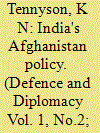

|
|
|
|
|
| Publication |
2012.
|
| Summary/Abstract |
Afghanistan is India's most important neighbouring country, with
which India has shared strategic, economic and political interests for
centuries. However, India-Afghanistan relations officially began only
after India's independence, more specifically after the signing of the
Treaty of Friendship between the two countries on January 4, 1950. As
early as March 22, 1949, Jawaharlal Nehru, the first Prime Minister of
India, emphasising the geo-political importance of India's neighbouring
countries (including Afghanistan) for India's foreign policy, remarked
during his lecture at the Indian Council of World Affairs (ICWA),
New Delhi, "[T]he nearby countries always have a special interest in one another and India must, inevitably, think in terms of her relations
with the countries bordering her by land and sea…I would also include
Afghanistan, although it does not touch India's borders; Tibet and
China, Nepal, Burma, Malaya, Indonesia and Ceylon [Sri Lanka]."
1
Since
then, successive Indian leaders have taken great interest in the political
developments in Afghanistan and its neighbouring countries, because a
political crisis in the region, directly or indirectly, spills over to India and
affects its strategic and security interests.
|
|
|
|
|
|
|
|
|
|
|
|
|
|
|
|
| 6 |
ID:
114451


|
|
|
|
|
| Publication |
2012.
|
| Summary/Abstract |
Pakistan has been in existence for more than six decades but the state
has not been able to define its identity till date. Born as a result of the
demand for a separate Muslim homeland, it eventually stood as the
saviour of Islam and, in the process, the military led country has adopted
policies based on religion which have had severe repercussions for the
state. Religion has been used in Pakistan in roles ranging from nationbuilding to strategic security.
|
|
|
|
|
|
|
|
|
|
|
|
|
|
|
|
| 7 |
ID:
114440
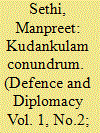

|
|
|
|
|
| Publication |
2012.
|
| Summary/Abstract |
The first of the two 1,000 MW nuclear power plants under construction
for the last decade
1
at Kudankulam was due to become operational before
the end of this year. What it stares at instead is a delayed future after the
Tamil Nadu Cabinet passed a resolution in September 2011 to suspend
work on the nuclear reactor. Chief Minister Jayalalitha claimed to have
been compelled to do so in response to the public protests against the
nuclear plant, and she certainly had an eye on the local elections that
were due less than a month before the protests broke out.
2
|
|
|
|
|
|
|
|
|
|
|
|
|
|
|
|
| 8 |
ID:
114444
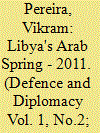

|
|
|
|
|
| Publication |
2012.
|
| Summary/Abstract |
In the 15th and the 16th centuries, the Barbary coast, a strip of North
Africa, known because of the Berbers, came under the scanner of
the two principal players in the Mediterranean at that time: namely,
Spain in the west and Turkey in the east. This rivalry lasted for much
of the 16
th
century but was subtly won in a fairly unorthodox manner
by the Turks who allowed Turkish pirates or corsairs to establish
themselves along the coast; the territories seized by the corsairs were
then given a formal status as protectorates of the Ottoman Empire.
The first such pirate established himself on the coast of modern-day
Algeria in 1512, followed by others (in what is today's Libya) in 1551;
Khair-ed-Din (popularly known as Barbarossa took over Tunisia,
very briefly in 1534, but the territories were recovered for Spain
in 1535 and finally brought under Ottoman control in 1574. P
|
|
|
|
|
|
|
|
|
|
|
|
|
|
|
|
| 9 |
ID:
114450
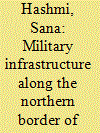

|
|
|
|
|
| Publication |
2012.
|
| Summary/Abstract |
It is often said, "Good fences make good neighbours"-an old dictum,
which has rarely been proved wrong in the history of mankind. Countries
across the continents have often got entangled in wars due to disputes
arising out of conflicting territorial claims. Unsurprisingly, therefore, the
boundary issue has a crucial role in defining the relationship between
the two giants of Asia i.e. India and China
|
|
|
|
|
|
|
|
|
|
|
|
|
|
|
|
| 10 |
ID:
114441


|
|
|
|
|
| Publication |
2012.
|
| Summary/Abstract |
Those who have been observing China have little doubt that China has
put in substantial effort in modernising her naval forces, especially in
the last decade or so. The genesis of the maritime component of China's defence strategy lies in the People's Republic of China's (PRC's) 1982
Naval Maritime Plan, outlined by then Vice Chairman of the Military
Commission, Liu Huaqing. This naval strategy defined three stages
and goals for the People's Liberation Army (PLA) Navy. In the first
stage, from 2000 to 2010, China was to establish control of waters
within the first island chain that links Okinawa Prefecture, Taiwan
and the Philippines. In the second stage, from 2010 to 2020, China
would seek to establish control of waters within the second island
chain that links the Ogasawara island chain, Guam and Indonesia.
In the final stage, from 2020 until 2040, China would aim to put an
end to US military dominance in the Pacific and Indian Oceans,
using aircraft carriers as a key component of its military force. The
current developments and the recent impetus on modernisation find
alignment with this very datum.
|
|
|
|
|
|
|
|
|
|
|
|
|
|
|
|
| 11 |
ID:
114447


|
|
|
|
|
| Publication |
2012.
|
| Summary/Abstract |
Presently, the world seems to be facing a nuclear turning point.
1
Whereas certain optimists view the existence of nuclear weapons
as, to some extent, likely to stabilise international security, nuclear
security has emerged as one of the most fearful threats to global
security. The growing accuracy and predictable use of nuclear
weapons is now, more than ever, creating a need for world leaders
to control and eliminate the dangers posed by the acquisition of such
weapons by aspiring parties and nations. In the meantime, though
the Fukushima nuclear disaster in Japan threatens to disrupt nuclear
energy programmes in the world, it is undeniable that the demand
for nuclear energy is increasing in many countries, thus, making it
imperative that we earnestly contemplate the many ramifications of
these developments. At this point, while it is difficult to separate the
military and civilian uses of nuclear technology, there is a need for
legitimised and organisational action to work against illegal nuclear
proliferation on a global level, which will require much goodwill and
cooperation among nations.
|
|
|
|
|
|
|
|
|
|
|
|
|
|
|
|
| 12 |
ID:
114448


|
|
|
|
|
| Publication |
2012.
|
| Summary/Abstract |
In retrospect, nuclear technology has brought forth a mixture of
rational and not-so-rational views, well-founded concerns as well
as baseless fears.
1
On the one hand, the three nuclear disasters -
Three Mile Island, Chernobyl and Fukushima Daiichi - have made
the study of safety and security of high-technological systems like
nuclear, contentious. In addition, the spectre of 9/11 has raised
the fear of terrorists targeting nuclear infrastructure. On the other
hand, over 14,000 cumulative reactor years of commercial nuclear
operation in 32 countries suggest that the danger from nuclear
activity is minimal and nuclear energy can be harnessed in a safe
and secure manner.
2
|
|
|
|
|
|
|
|
|
|
|
|
|
|
|
|
|
|
|
|
|